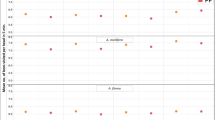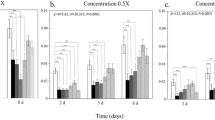Abstract
The immune system of bees is influenced by a diversity of factors, some of which have changed in the last 10 years such as the application of pesticides. In addition to pollen, nectar and dust, guttated water of seed-dressed plants might be a new source of contamination to bees. Our experiments demonstrated that guttated water of plants germinated from seeds dressed with neonicotinoids contains neonicotinoids. Maize seeds treated with clothianidin (Poncho® 0.5 mg/seed and Poncho® Pro 1.25 mg/seed) resulted in neonicotinoid concentrations up to 8,000 ng mL−1 in the guttated fluid. This concentration decreases rapidly, but remained detectable over several weeks. Seeds treated with Poncho® Pro did not result in higher concentrations in guttated droplets in the first stages of plant development, but the concentration decreased more slowly. Triticale seed treated with imidacloprid contained small quantities of this active agent (up to 13 ng mL−1) in the guttated fluid the following spring after overwintering. During the sampling of guttation fluid, no bees were observed collecting these droplets from triticale or maize. To evaluate the attractiveness of guttation fluid exuded from seed-treated plants under field conditions, more studies are required.







Similar content being viewed by others
References
Butler, C.G. (1940) The choice of drinking water by the honeybee. J. Exp. Biol. 17, 253–261
Cutler, G.C., Scott-Dupree, C.D. (2007) Exposure to clothianidin seed-treated canola has no long-term impact on honey bees. J. Econ. Entomol. 100(3), 765–772
Decourtye, A., Devillers, J., Genecque, E., Le Menach, K., Budzinski, H., Cluzeau, S., Pham-Delègue, M.-H. (2005) Comparative sublethal toxicity of nine pesticides on olfactory learning performances of the honeybee Apis mellifera. Arch. Environ. Contam. Toxicol. 48, 242–250
Desneux, N., Decourtye, A., Delpuech, J.-M. (2007) The sublethal effects of pesticides on beneficial arthropods. Annu. Rev. Entomol. 52, 81–106
Halm, M.-P., Rortais, A., Arnold, G., Taséi, J.N., Rault, S. (2006) New risk assessment approach for systemic insecticides: the case of honey bees and imidacloprid (Gaucho). Environ. Sci. Technol. 40(7), 2448–2454
Harries, R.I. (1999) Guttation—the basis of an assay for evaluating formulation behaviour in vivo. Pestic. Sci. 55, 582–584
Iwasa, T., Motoyama, N., Ambrose, J.T., Roe, R.M. (2004) (2003) Mechanism for the differential toxicity of neonicotinoid insecticides in the honey bee, Apis mellifera. Crop Protection 23, 371–378
Jeschke, P., Nauen, R. (2008) Neonicotinoids – from zero to hero in insecticide chemistry. Pest. Manag. Sci. 64, 1084–1098
Kühnholz, S., Seeley, T.D. (1997) The control of water collection in honey bee colonies. Behav. Ecol. Sociobiol. 41(6), 407–422
Liu, M.Y., Lanford, J., Casida, J.E. (1993) Relevance of [3H]imidacloprid binding site in house fly head acetylcholine receptor to insecticidal activity of 2-nitromethylene-and 2-nitroimino-imidazolidines. Pestic. Biochem. Physiol. 46, 200–206
Maienfisch, P., Angst, M., Brandl, F., Fischer, W., Hofen, D., Kayser, H., Kobel, W., Rindlisbacher, A., Senn, R., Steinemann, A., Widmer, H. (2001) Chemistry and biology of thiamethoxam: a second generation neonicotinoid. Pest. Manag. Sci. 57, 906–913
Oldroyd, B.P. (2007) What's killing American honey bees? PLoS Biol. 5, e168
Rosenkranz, P., Wallner, K. (2009) The chronology of honey bee losses in the Rhine Valley during spring 2008: an example of worst case scenario. Proceedings of the Third European Conference of Apidologie, Dublin, Ireland, 7–11 September 2008, 94–95
Schmuck, R. (1999) Imidacloprid - Kein Zusammenhang zwischen Saatgutbeizung mit Gaucho® in Sonnenblumen und Bienenschäden in Frankreich. Pflanzenschutz-Nachr. Bayer 52, 267–310
Schmuck, R. (2004) Effects of a chronic dietary exposure of the honeybee Apis mellifera (Hymenoptera: Apidae) to Imidaclorpid. Arch. Environ. Contam. Toxicol. 47, 471–478
Schmuck, R., Keppler, J. (2003) Clothianidin—ecotoxicological profile and risk assessment. Pflanzenschutz-Nachrichten Bayer 56, 26–58
Schmuck, R., Schöning, R., Stork, A., Schramel, O. (2001) Risk posed to honeybees (Apis mellifera L, Hymenoptera) by an imidacloprid seed dressing of sunflowers. Pest. Manag. Sci. 57, 225–238
Suchail, S., Guez, D., Belzunces, L.P. (2001) Discrepancy between acute and chronic toxicity induced by imidacloprid and its metabolites in Apis mellifera. Environ. Toxicol. Chem. 20, 2482–2486
Suchail, S., de Sousa, G., Rahmani, R., Belzunces, L.P. (2004) In vivo distribution and metabolisation of 14C-imidacloprid in different compartments of Apis mellifera L. Pest Manag. Sci. 60, 1056–1062
VanEngelsdorp, D., Evans, J.D., Saegerman, C., Mullin, C., Haubruge, E., Nguyen, B.K., Frazier, M., Frazier, J., Cox-Foster, D., Chen, Y., Underwood, R., Tarpy, D.R., Pettis, J.S. (2009) Colony collapse disorder: a descriptive study. PLoS ONE 4, e6481
Villa, S., Vighi, M., Finizio, A., Serini, G.B. (2000) Risk assessment for honeybees from pesticide-exposed pollen. Ecotoxicology 9, 287–297
Visscher, P.K., Crailsheim, K., Sherman, G. (1996) How do honey bees (Apis mellifera) fuel their water foraging flights? J. Insect. Physiol. 42, 1089–1094
Wallner, K. (2006) Pflanzenschutzmitteleinsatz in blühende Kulturen und der Wirkstofftransport in Bienenvölker. BVL - Das “Bienensterben” im Winter 2002/2003 in Deutschland, 60–67
Wallner, K. (2009) Sprayed and seed dressed pesticides in pollen, nectar and honey of treated oil seed rape. Hazard of pesticides to bees. Julius Kühn-Archiv 423, 152–153
Acknowledgements
The authors thank the staff members of the field site Heidfeldhof for assistance and providing us experimental sites. Furthermore, we thank Dr. Helen M. Thompson for proofreading the manuscript.
Author information
Authors and Affiliations
Corresponding author
Additional information
Manuscript editor: Monique Gauthier
Présence d'insecticides néonicotinoïdes dans les gouttelettes exsudées par guttation sur les plants de maïs et de blé issus de graines traitées par enrobage: une menace pour les abeilles?
Graines traitées par enrobage / néonicotinoïdes/guttation / Apis mellifera / LC-HR-MS
Freisetzung neonicotinoider Insektizide aus der Saatgutbeizung in Guttationstropfen bei Mais und Getreide: Eine Gefahr für Honigbienen?
Saatgutbeizung / Neonicotinoide / Guttationswasser / Apis mellifera / LC-HR-MS
An erratum to this article can be found at http://dx.doi.org/10.1007/s13592-011-0093-x
Rights and permissions
About this article
Cite this article
Reetz, J.E., Zühlke, S., Spiteller, M. et al. Neonicotinoid insecticides translocated in guttated droplets of seed-treated maize and wheat: a threat to honeybees?. Apidologie 42, 596–606 (2011). https://doi.org/10.1007/s13592-011-0049-1
Received:
Revised:
Accepted:
Published:
Issue Date:
DOI: https://doi.org/10.1007/s13592-011-0049-1




